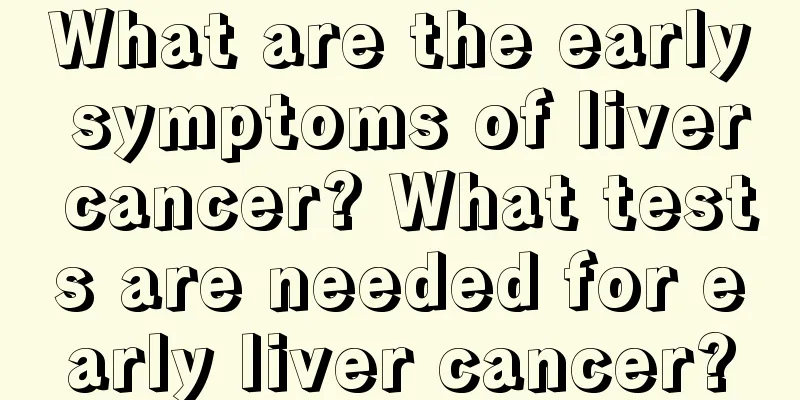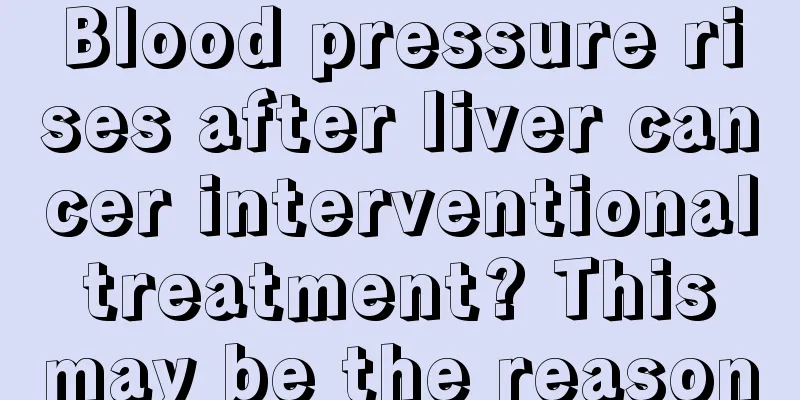What are the early symptoms of liver cancer? What tests are needed for early liver cancer?

|
Everyone may have heard of liver cancer, but it is not good news. Everyone may know some of the early symptoms of liver cancer, but they are often ignored. The early symptoms are not obvious and hidden, which troubles people's prevention of liver cancer. The following is a summary of the early symptoms of liver cancer: 1. Pain in the liver area It is often caused by the rapid growth of liver tumors, which increases the tension of the liver capsule, or the tumors involve the liver capsule. It is often the first symptom of mid-to-late stage liver cancer. The pain is mostly located in the right ribs or under the xiphoid process. At the beginning, it is mostly intermittent or continuous dull pain or stabbing pain. The pain may be mild or severe or relieve itself within a period of time, or even disappear. The pain is often obvious at first, and sometimes painkillers are needed. If the tumor is located at the top of the diaphragm of the right lobe of the liver, the pain can often radiate to the right shoulder or right back; if the tumor is located in the left lobe of the liver, distension and pain in the upper and middle abdomen will appear earlier; when the tumor is located in the empty space of the right lobe of the liver, there are generally few symptoms. The pain may radiate to the right shoulder or right back due to liver rupture or tumor bleeding under the liver capsule. 2. Digestive tract symptoms Common symptoms include decreased appetite, upper abdominal fullness after meals, or even nausea, vomiting, or diarrhea. Digestive tract symptoms are often caused by pathological changes in the liver, which lead to increased portal vein system pressure and digestive tract dysfunction; or by enlarged tumors compressing or involving the stomach. 3. Weight loss and fatigue It often occurs in the middle and late stages of liver cancer. It may be caused by tumor metabolites causing changes in the body's biochemical metabolism, coupled with reduced food intake. In severe cases, cachexia may occur. 4. Fever The fever caused by liver cancer is generally around 37.5℃~38℃, occasionally reaching above 39℃, with irregular fever pattern, usually without chills, and more common in the afternoon, sometimes with remittent high fever. Fever can be caused by tumor necrosis or its metabolites. Generally speaking, when the body experiences unrelieved fatigue and exhaustion, it is necessary to promptly compare other early symptoms of liver cancer that one has mastered, such as pain. The best way is to go to a regular professional hospital for examination in a timely manner, as such conditions are largely liver cancer. What tests should patients with liver cancer take to the hospital to be diagnosed? Many family members waste a lot of time taking patients to the hospital because they don’t know how to take the patients for examination. This not only causes physical pain to the patients, but also causes psychological pressure on the patients. Let’s take a look at the tests that need to be done for liver cancer. 1. Alpha-fetoprotein determination: This diagnostic method uses an immune method to determine the production of embryonic antigens. It is currently one of the most effective methods for diagnosing this disease. If no other evidence of liver cancer is found, the positive α-Fp countercurrent immunoelectrophoresis method is greater than 500ng/ml and lasts for more than one month, active liver cancer and pregnancy are excluded, and gonadal embryonic tumors are excluded, liver cancer can be diagnosed. 2. Blood enzyme examination: The serum γ-glutamyl transpeptidase of patients with this disease is higher than that of normal people. The lactate dehydrogenase isoenzyme and alkaline phosphatase are also higher than those of normal people. However, this diagnosis lacks specificity and is therefore only used as an auxiliary diagnosis. 3. Ultrasound examination: What are the accurate diagnosis methods for liver cancer? Ultrasound examination is currently a better method for diagnosing this disease. Its advantage is that it can be detected without invasion. The size and shape of the tumor and the presence of cancer thrombus in the hepatic vein and portal vein can be accurately displayed, with a diagnosis rate of up to 84%. Lesions with a diameter of less than 2 cm can also be found. 4. CT examination: This method has the characteristics of high resolution in diagnosing liver cancer. It can detect early liver cancer patients with a diameter of about 1 cm. Enhanced scanning can help identify hemangiomas. The accuracy rate of diagnosing liver cancer is as high as 90%, but the cost is relatively high, so it is not widely used. 5. X-ray examination: What are the accurate diagnosis methods for liver cancer? X-ray examination of the abdomen or plain film can reveal the enlargement of the liver shadow. The right diaphragm rises in the right lobe of the liver, thus limiting the patient's activities. It may also be a localized bulge, which is related to the left lobe of the liver and giant liver tumors. X-ray barium meal examination can show symptoms of compression of the stomach and transverse colon. |
<<: Is lung cancer contagious in the late stage? Two things to note about late stage lung cancer
Recommend
How should patients with bone cancer who are depressed choose their diet
Studies have shown that about 66% of cancer patie...
How to properly take care of your skin in summer?
The weather is relatively hot in summer, so you m...
Several yoga moves that are beneficial for cervical spondylosis
Yoga has many benefits, especially for women. Man...
Is hair dye harmful to the body?
Hair dyeing may seem very ordinary, but it is act...
Plants with anesthetic effects
Anesthesia is necessary during surgery, and only ...
Things to note when getting hepatitis B vaccine
I believe that everyone has received the hepatiti...
What does the DTP vaccine prevent? This is what the DTP vaccine is all about.
Parents who have given birth to babies know that ...
What is the best diet therapy for lung cancer patients
Lung cancer is one of the most common malignant t...
How to quickly remedy loose powder on face
For many female friends, makeup can be said to be...
Your stomach is most afraid of four things
The stomach has four mortal enemies. Under the de...
How to check for ulcerative gastric cancer
Gastric cancer is a relatively harmful disease th...
Why does my left chest hurt when I cough?
For friends who have pain in the left chest when ...
Are oranges diuretic?
Orange is a common fruit in our lives and is also...
Allergic to Band-Aid
We often use Band-Aids in our daily lives. When t...
The most common early symptoms of bone cancer
There are many bone cancer patients in life, and ...









